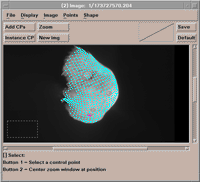Mission Update - September 2005
The science team continues to work on analyzing the data while at the same time trying to return to our normal daily routines that were interrupted due to the intense encounter phase. I don't know how the Mars or Cassini science teams do it. I can't imagine keeping up the pace of an encounter for years on end.
After our workshop meeting at the end of July we returned to our home institutions to continue working and writing the first publication for Science magazine. While Science magazine is available in public libraries, it is not a journal that can be bought on the news stand. We will be preparing summaries of the different aspects of the first science results for the Deep Impact web page over the next couple of months. We start with an explanation of the composite image of the nucleus of Tempel 1 seen before impact.
Below, I would like to summarize what we have learned about some of the basic properties of the comet nucleus. The first spectrometer results are briefly described. Future updates will go into some of the details of surface features on the comet nucleus, the impact process and its aftermath.
I know many of you wonder whether we have found the impact crater in our images. The answer to that is that we are still looking. The impact released a large amount of very fine-grained dust, which obscured the newly formed crater more effectively than we had anticipated during the short period we were observing with the flyby spacecraft. We have been scouring the post impact images, deconvolving them, stretching them, subtracting and dividing them every which way to see if we can find a feature that appears to be circular, in the location where we expect the impactor to have hit. The feature would not exist in pre-impact images. There will always be some uncertainty in the identification of this apparent crater, but we have a number of experienced experts in image processing and data deconvolution working on the task, as well as the rest of the science team who can place arguments of plausibility on any features that we find. I will warn you now, that no one will ever get a clear view of Deep Impact crater from the available images on hand at this point.
What shape is the nucleus?
You might look at the comet nucleus and see it as potato shaped. I've heard the PI say it looks like a carrot that Bugs Bunny took a bite of. The fact is that the shape of the nucleus is not totally known. We were only able to image slightly more than half of it as the comet sped overhead of the flyby spacecraft. The comet was moving extremely fast, 67,000 miles per hour (30 km/s), as was the spacecraft at 22,600 mph. We had only 13 minutes 20 seconds to observe the comet before entering shield mode. Hence, we did not get a chance to see the entire comet nucleus.
As the comet flew past, the MRI imaged about 25% of the nucleus, enough to get 70 control points in 43 images. Control points are discernible features that can be recognized in multiple images, see Figure 2. These are pieced together into a shape model consisting of plates that define the three dimensional figure of the nucleus, with gaps of course, because we didn't see the entire nucleus. Figure 3 shows the grid representing the shape of the nucleus that is developed from multiple images at different view angles. It is difficult to define the shape but some of the dimensions can be specified, including the mean radius, of 3.0 +/- 0.1 km, the longest dimension, 7.6 km and the shortest of 4.9 km. Co-Investigator, Peter Thomas of Cornell University has worked with his team to derive the shape and the orientation of its spin pole, which points to a place in the sky designated at Right Ascension 5° and declination 73° (these are equivalent to latitude and longitudes on the celestial sphere).
Knowing the shape and the orientation of the pole about which the comet rotates, are critical pieces of information upon which the rest of our analysis is built.
--Lucy McFadden
|














